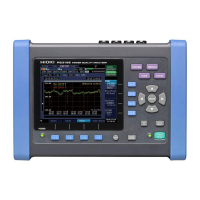13.8 Calculation Formula
241
10
13
Chapter 13 Specifications
c: measurement channel; k: order of analysis; r: resistance after FFT; i: reactance after FFT
c: measurement channel
-10. Harmonic Voltage Phase Angle (Uphase), Harmonic Current Phase Angle
(Iphase), Phase Difference of Harmonic Voltage and Harmonic Current (Pphase)
Single Phase 2-wire
1P2W
Single Phase 3-wire
1P3W
3-Phase, 3-Wire,
2-Measurement
3P3W2M
3-Phase, 3-Wire,
3-Measurement
3P3W3M
3-Phase, 4-Wire
3P4W
Uphase[deg]=θUk
θ
U1k
θ
U4k
θ
Uck=tan
-1
θ
U1k
θ
U2k
θ
U4k
θ
U12k
θ
U32k
θ
U4k
θ
U12k
θ
U23k
θ
U31k
θ
U4k
θ
U1k
θ
U2k
θ
U3k
θ
U4k
• For 3-phase 3-wire connections, indicated values represent harmonic calculation results obtained using line voltage.
• The harmonic voltage phase angle is displayed after cor
rection using the reference channel’s fundamental
wave to 0°.
• When Uckr=Ucki=0,
θ
uk=0
°
• The harmonic voltage used in calculations is calculated using only whole-number orders.
Iphase[deg]=θIk
θ
I1k
θ
I4k
θ
Ick=tan
-1
θ
I1k
θ
I2k
θ
I4k
θ
I1k
θ
I2k
θ
4k
θ
I1k
θ
I2k
θ
I3k
θ
I4k
θ
I1k
θ
I2k
θ
I3k
θ
I4k
• The harmonic voltage phase angle is displayed after correction using the reference channel’s fundamental
wave to 0°.
• When Ickr=Icki=0,
θ
Ik=0
°
• The harmonic voltage used in calculations is calculated using only whole-number orders.
Pphase[deg]=θk
θ
1k
θ
ck
=
θ
cIk
-
θ
cUk
θ
1k
θ
2k
θ
1k
θ
2k
θ
3k
θ
sum
=tan
-1
θ
sum
=tan
-1
θ
sum
=tan
-1
θ
sum
=tan
-1
• When Psumk=Qsumk=0,
θ
k=0
°
• Psumk indicates the total harmonic power (see the equations for harmonic power).
• Qsumk indicates total harmonic reactive power (see the equ
ations for harmonic reactive power).
-11. Voltage Flicker (dV10), Short Interval Voltage Flicker (Pst), and Long Interval Volt-
age Flicker (Plt)
Single Phase 2-wire
1P2W
Single Phase
3-wire
1P3W
3-Phase,
3-Wire,
2-Measurement
3P3W2M
3-Phase,
3-Wire,
3-Measurement
3P3W3M
3-Phase,
4-Wire
3P4W
dV10=ΔV10
Δ
V10
(1)
Δ
V10
(c)
=
Δ
V10
(1)
Δ
V10
(2)
Δ
V10
(12)
Δ
V10
(32)
Δ
V10
(12)
Δ
V10
(23)
Δ
V10
(31)
Δ
V10
(1)
Δ
V10
(2)
Δ
V10
(3)
• Uf represents the reference voltage for voltage flicker and indicates the 1-minute average of RMS voltage values.
• an represents the flicker luminosity coefficient corresponding to
the fluctuation frequency fn [Hz] calculated from
the flicker luminosity curve.
• ΔUn r
epresents the voltage fluctuation in fn.
Pst Pst
1
Pst
c
=
Pst
1
Pst
2
Pst
1
Pst
2
Pst
1
Pst
2
Pst
3
Pst
1
Pst
2
Pst
3
• Indicates values for K
1
=0.0314, K
2
=0.0525, K
3
=0.0657, K
4
=0.28, and K
5
=0.08.
• Calculations are performed using a 1,024-class cumulative pr
obability function (CPF).
• Results are calculated from cumulative pr
obability (Pi) values using linear interpolation, smoothed using the fol-
lowing methods, and used to calculate the cu
mulative probability (Pis):
P1s=(P0.7+P1+P1.5)/3, P3S=(P2.2+P3+P4)/3, P10s=(P6+P8+P
10+P13+P17)/5, P50s=(P30+P50+P80)/3
Plt Plt
1
Plt
c
=
Plt
1
Plt
2
Plt
1
Plt
2
Plt
1
Plt
2
Plt
3
Plt
1
Plt
2
Plt
3
• N indicates the number of measurements (N=12). (When N<12, the number of measurements is used as N.)
Uckr
Ucki–
----------------
Ickr
Icki–
----------------
Qsumk
Psumk
----------------
Qsumk
Psumk
----------------
Qsumk
Psumk
----------------
Qsumk
Psumk
----------------
100
U
f
2
---------
a
n
ΔU
n
×()
2
K
1
P
0.1
K
2
P
1s
K
3
P
3s
K
4
P
10s
K
5
P
50s
+++ +
Pst
n
()
3
n1=
N
N
-----------------------------
3

